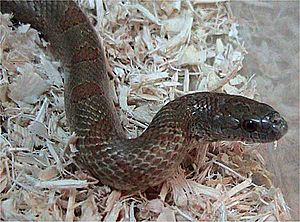Mole kingsnake facts for kids
Quick facts for kids mole kingsnake |
|
|---|---|
 |
|
| mole kingsnake, Lampropeltis calligaster rhombomaculata | |
| Scientific classification |
|
| Kingdom: | Animalia |
| Phylum: | Chordata |
| Class: | Reptilia |
| Order: | Squamata |
| Suborder: | Serpentes |
| Family: | Colubridae |
| Genus: | Lampropeltis |
| Species: | |
| Subspecies: |
L. c. rhombomaculata
|
| Trinomial name | |
| Lampropeltis calligaster rhombomaculata (Holbrook, 1840)
|
|
| Synonyms | |
|
|
The mole kingsnake (scientific name: Lampropeltis calligaster rhombomaculata) is a type of snake. It is also called the brown kingsnake. This snake is a subspecies of the prairie kingsnake.
Contents
Where Mole Kingsnakes Live
Mole kingsnakes live in the southeastern and Mid-Atlantic States. You can find them across these areas. However, they do not live in the Appalachian Mountains.
What Mole Kingsnakes Look Like
Mole kingsnakes are usually light brown or gray. They have dark brown, orange, or reddish-brown blotches. These blotches run along their entire body.
These snakes can grow quite long. They typically reach lengths of 30 to 40 inches (76.2 to 101.6 cm). That's about as long as a baseball bat!
It can be tricky to tell them apart from other snakes. They look similar to the milk snake and the copperhead. Both of these snakes live in the same places. The copperhead is a venomous snake, but the mole kingsnake is not.
Some mole kingsnakes have very faint markings. They might look almost solid brown. Young mole kingsnakes, called juveniles, have brighter colors. Their markings are also more noticeable. They often have small reddish spots on their heads.
Mole Kingsnake Behavior
Mole kingsnakes prefer to live in open fields. They like places with loose, dry soil. You often find them near the edge of a forest.
Their main food source is rodents, like mice. But they also eat lizards, frogs, and sometimes other snakes. Mole kingsnakes are not venomous. They are usually calm and gentle.
If they feel threatened, they might vibrate their tail quickly. This is a common defense for many snakes. Mole kingsnakes are very shy. They spend a lot of time underground. They are rarely seen above ground during the day. However, heavy rains might force them out. These snakes are mostly active at night. You might spot them on paved roads after dark.
Reproduction and Life Cycle
Male and female mole kingsnakes mate in late spring to early summer. This usually happens around May or June. Female snakes leave behind special scent trails called pheromones. Male snakes use their forked tongues to find these trails.
After mating, the female snake finds a safe spot. She might choose a place underground or inside a rotting log. She lays about 10 to 12 eggs. The eggs hatch later in the summer. The mother snake does not stay to care for her babies. She leaves shortly after laying the eggs. It takes about ten days for the newly hatched snakes to become fully independent.

